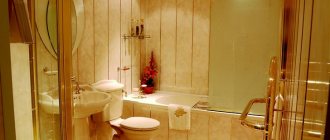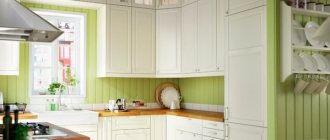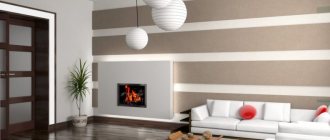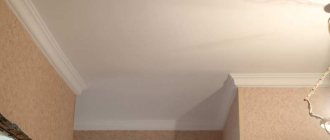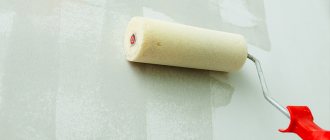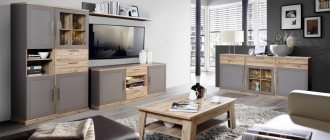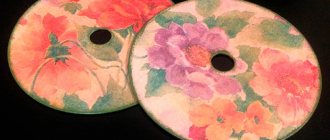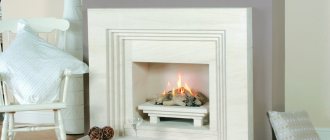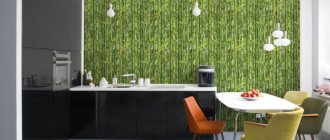If you want your balcony to become an excellent place to relax, you can line it with clapboard using environmentally friendly and natural materials. The question is how to cover a balcony with clapboard with your own hands, however, anyone who has held construction tools in their hands at least once in their life can solve it.
By the way, with the help of lining you can not only improve the appearance of the balcony and make it more comfortable, but also additionally insulate it by about 15 degrees, which will make this room more suitable for long gatherings, work or games at any time of the year.
In the presented material we will talk about the types of lining and how to properly sheathe a balcony with it yourself. Also attached to the article is a training video and photos of finished balconies and work processes.
Types of lining
In most cases, lining means exclusively wooden boards of a special shape. But recently they have also begun to use the so-called plastic lining made from PVC panels. Outwardly, they are practically no different from each other.
Discrepancies can be detected during the purchase, paying attention to the cost, as well as in the methods of caring for the material.
Wood, of course, is given greater preference, since it is a natural and environmentally friendly product. Prices may vary significantly depending on the region.
To preserve its appearance, it is necessary to treat it with special compounds based on chemical elements.
- In terms of practicality, PVC lining is not inferior, since it is easy to handle, it is easy to wash, and it does not require any special care. Just as there is no need for additional antiseptics and stains.
- For quite a long time, it is able to maintain its original appearance, except that under the influence of natural daylight it may fade a little.
Description
Eurolining is called wooden boards that are processed on all sides along the edges. The material has a tongue-and-groove type of connection, which allows for cladding without visible joints or fastenings. When a perfectly smooth surface is not required, it is better to use air ducts that are located on the back of the eurolining. This will prevent harmful condensation from forming.
The category of building material is determined immediately after the manufacturing process (depending on the presence of various defects, curvatures, etc.); during sorting, it is divided into 4 grades. Products are divided into classes:
- “Extra” - there are no defects whatsoever, the lining is impeccably even and smooth;
- A – there may be 2 cracks, 1 knot, 2 resin pockets, while the diameter of the second one can be from 5 to 15 mm;
- B - the number of cracks and resin pockets is the same as in the previous case, but the possible number of knots increases to 4 (diameter - 20 mm);
- C – many unsightly stripes and blue spots, cracks, knots and resin pockets.
Installation of lining
This type of finishing begins to be installed from the corner part of the room. The first board is secured with self-tapping screws. You need to pre-drill the holes a little so that the board does not crack. The spikes can be left as they are, as they will not be visible when the job is completed.
All elements are attached in strict sequence one after another. They need to be fixed in a certain way. That is, the ridge of the board is inserted into the groove of the previous one, it is carefully pushed into it using a hammer or rubberized mallet.
In a geometrically correct room, you need to cut the boards to the same size. If the room is of irregular shape, you will have to take measurements for each block of 3-4 elements.
The last panel is trimmed. It must be firmly secured. Small gaps are left in the lower and upper parts for possible deformations.
Opening with varnish
The final stage of finishing the balcony will be varnishing the lining.
It is acceptable to leave the lining “as is”, but if you want the balcony sheathed with your own hands to last as long as possible, it is better not to neglect this stage. Opening with varnish will minimize the impact of moisture and ultraviolet radiation on the boards and will serve functional and decorative purposes. Numerous transparent or tinted varnishes make it possible to imitate almost any type of wood, which will greatly please those who are not happy with the natural color of the lining or want to create an interior in a single color scheme. Photo of the balcony after finishing with clapboard.
That's it, your balcony is lined and ready to use!
Many houses have an unheated room such as a balcony or loggia. How to insulate it and make it suitable for normal use in winter will help.
Residents of Khrushchevkas are familiar with the situation of disorder on the scanty balconies that these legendary buildings of the USSR are equipped with. In order to somehow organize it.
The article talks about the technology of covering the ceiling on a balcony with plastic panels, including preparatory work and installation of the ceiling.
Methods for restoring balcony slabs, their characteristics, and possible options for strengthening are considered using the example of repairing a balcony slab in a Khrushchev-era building.
We will show you how to arrange cabinets under the parapet on a balcony with a carry-out, mark and attach frame profiles under the sheathing, and sheathe the balcony parapet.
Do-it-yourself clapboard cladding
Self-cladding with clapboard requires compliance with the following sequence of actions:
- First of all, it is necessary to dismantle the old finish: get rid of layers of paint, old plaster and everything that does not hold strong enough. Before insulating and covering the walls with clapboard, you must treat the walls several times with a primer, and the floor and ceiling with antiseptics.
- The walls, together with the ceiling, must be covered with lathing. Regular wooden blocks will also work. The width of the bars depends on the width of the insulation layer.
- Special logs are installed in the floor.
- Insulation is applied to the gaps between the joists.
- The lining is installed on the walls.
- The ceiling is being sheathed
- After completing the installation of the walls with clapboards, you can finally begin installing skirting boards and slopes.
The working process
It is worth familiarizing yourself with the features of how to make a hallway with your own hands. If you have a small room, then give preference to those items that will not overload it. With a minimum number of square meters, you can use compartments designed to store outerwear, shoes, as well as the items you need.
If you have a spacious hallway, then you can use a spacious closet. Depending on its parameters, the cost of the product is calculated.
After determining the model, it is necessary to take measurements and make accurate calculations. Prepare a set of tools that will be useful during work.
Balcony insulation
Before you start covering the walls with clapboard, you need to take care of their insulation.
To do this, you can use any insulation:
- Foam plastic: this type of insulation is one of the most affordable, since its cost is very low. It can be purchased at any hardware store in the form of large slabs. It conducts heat well. BUT! Unfortunately, he tolerates the load very poorly. Although, after clapboard cladding, such a drawback will not be noticeable. Many people refuse to use it because they believe that it can release toxic substances. On the one hand, this is explained by its nature - it is an artificially created material, and on the other hand, it is capable of releasing toxins only under certain conditions. In most cases, it is absolutely safe for humans. It also cannot remove fumes, but here only a high-quality ventilation system can come to the rescue;
- Cotton wool: Mineral wool is made from rock or slag, and unlike polystyrene foam, it is completely natural. Its advantages include excellent heat conductivity and ease of handling. The disadvantage can be considered hygroscopicity, which is why it must be completely isolated from the source of moisture;
- EPS: extruded polystyrene foam has excellent density, conducts heat well and is difficult to deform due to mechanical stress. Moreover, it muffles sounds. Among other insulation materials, it can be called the highest quality. The only disadvantages are moisture impermeability and high price;
- Foam glass: foam glass is non-flammable and practically does not burn, is considered the most environmentally friendly material, is light in weight, high strength and frost resistance.
Work organization
The good thing about finishing balconies with clapboards yourself is that the work does not require special skills or sophisticated equipment. Below are step-by-step instructions, which are divided into 2 parts:
- preparatory;
- main
You need to follow simple guidelines and be careful to get the job done.
During the work process, do not forget about lighting equipment
Part 1 - preparatory activities
First you need to purchase materials, the list is presented in the table.
| Materials | Recommendations for selection |
| Lining | You choose the version of the planks yourself; there are many options. The required quantity is determined simply: the length and width of the ceiling are measured and the quadrature is calculated |
| Bar | The frame will be constructed from it. The thickness of the elements depends on whether insulation will be performed. If insulation is present, the frame must be no thinner than the insulation |
| Fasteners | The frame is secured using dowel nails. Finishing a balcony with wooden paneling is done using nails or special fasteners called clamps |
| Insulation | Used when necessary; if not needed, the frame can be made thin |
You can use the option with a reflective layer to further retain heat on the balcony
Finishing of loggias and balconies with clapboard is done using special tools:
A building level, tape measure and pencil are needed to control the plane and measure work. To create a reference plane, you can pull the cord; this is very convenient for ceiling work;
Perforator for drilling the ceiling;
Hammer and hammer - if nails will be used. If you fasten the clamps with self-tapping screws, you will need a screwdriver;
Ladder or stable table. Finishing balconies with clapboards, or rather covering the ceiling, is impossible without using either a ladder or a table
It is important to ensure ease of work.
It is important to ensure safety when working
Part 2 - Workflow
Let's figure out how to decorate a balcony with clapboard.
The process for covering the ceiling is as follows:
Measurements. First of all, we need to take measurements and cut the block into pieces of the size we require. Do not forget that the frame is located perpendicular to the position of the lining
It is also important to leave 5 mm gaps at the edges so that the wood does not deform due to changes in temperature and humidity;
Drilling. Holes are made in the block through which drilling is carried out in concrete
After this, the elements are secured using dowel nails. To align the structure evenly, you may need to place blocks under the frame at the distance you need; this is especially important when using insulation;
It is important to set the frame level
Surface insulation. If insulation is required, the material is cut so that the pieces are wider than the distance between the bars. This will allow you to fill the cavities very tightly, without securing the mineral wool with dowels. If you use polystyrene foam, then it is better to fill all the joints with polyurethane foam; it will serve both as an adhesive and as a heat insulator;
Mineral wool is more convenient to use, as it does not leave gaps in the gaps
Preparing the lining. When the structure is ready, you can proceed to the next part of the work (by the way, finishing with plastic lining is done in exactly the same way before this stage). First of all, you need to take measurements to determine the length of the elements (do not forget about the necessary clearances). Cutting is done either with a hand saw with a fine tooth, or with a power tool;
It is important to take accurate measurements so as not to cut off too much and ruin the material.
- Fastening is done from any side; usually the part of the ceiling that is best visible is selected. The first element is placed close to the wall with the tenon facing forward;
- From the edge, the fastening is done directly through the lining, the joint will still close;
- On the groove side, the element is fixed either with nails or clamps, there is not much difference in this;
Fit. In order for a ceiling trimmed with clapboard to look its best, it is worth combining the planks tightly.
- To do this, each element is tapped through a wooden spacer so that the joints are as tight as possible;
Fastening is done only from the groove side; there is nothing complicated in the process;
It is important to fit the products together well
The measurements of the holes in the lining are determined locally; they should not be taken in advance
Means for processing lining
When you cover a balcony with clapboard, you need to take care to treat not only the surface of the finish with antiseptics, but also absolutely all of its entire strips.
To interact with the lining, it is recommended to choose the following impregnation and primer products, which favorably emphasize its texture:
- Aquadecor: this antiseptic has a coloring effect. Moreover, its tasks include comprehensive protection of wooden surfaces from fungi and various insects. It is usually applied last.
- Aquatex: protects the lining, but requires an additional layer of varnish on top.
- U-409: this impregnation helps create a special layer on the surface of the wood that looks like a film. It allows steam to pass through, but protects against dirt particles. Helps maintain the original appearance of wood trim.
Before directly applying special products. You must carefully read the instructions that are on the packaging of absolutely any protective product. This instruction manual describes all the nuances of its use, precautions and dosages.
If you strictly follow everything that is written there, you can achieve the maximum protective effect so that the lining together with its frame will last a long time.
Most stains also have protective properties, but unlike antiseptics, almost all compositions change the color of the wood. Moreover, they initially contain non-washable antiseptics, and manufacturers present a wide palette of shades.
- This type of finish can be processed in various ways. Experts say that the most convenient option is to use antiseptics.
- However, it is worth considering the fact that a one-time treatment can only protect against pests, but cannot close the pores in the wood and protect it from dirt.
- To do this, you will need special impregnations, the protective functions of which include repelling dirt.
- If your balcony is located on the sunny side, then, of course, you will be curious about how to protect the tree from direct sunlight.
- The ideal way out of the situation would be to use a light tint.
- It will be able to slightly discolor and whiten the wood flooring. After all, everyone knows that lighter colors are least susceptible to fading.
To add shine to a wooden surface, use a varnish with a glossy effect.
Video instructions and life hacks from masters
Installation of eurolining - step-by-step manual:
The video is chaotic, but the advice is really sensible:
Installation errors:
Despite the fact that finishing a balcony with clapboard is a large amount of work and a lot of wasted time, you can do everything yourself. In a situation where a beautiful and warm balcony needs to be done quickly, it is better to invite craftsmen.
YOU MAY ALSO BE INTERESTED
Photo of a balcony covered with clapboard
What do you need for work?
In addition to the lining itself, you will need construction tools and accessories.
Tool:
- Hammer/drill, preferably high power;
- Screwdriver (preferably, but you can use a drill);
- Bit holder and bit set for screwdriver/drill;
- Hammer;
- Hacksaw/jigsaw;
- Various brushes for applying primer and antiseptic;
- Building level;
- Pencil, ruler, square.
Materials:
- Polyurethane foam;
- Polyethylene foam;
- Scotch tape (painting);
- Frame material (metal profile or timber);
- Lining;
- Holders for lining;
- Nails, screws;
- Decorative elements (corners, baseboards);
- Varnishes/paints for wood);
- Priming;
If necessary - insulation, film to protect the insulation.
Application procedure
Before treating the lining on the balcony with paints and varnishes, it is necessary to prepare it for this procedure. You should approach each stage responsibly: the service life of the wood and the decorativeness of the coating directly depend on the quality of their implementation.
Each means for processing lining has its own technical characteristics and application features. Therefore, before starting work, you must read the instructions from start to finish, and then adhere to the rules specified in it.
Particular attention should be paid to the “Precautionary Precautions” section
Preparation
If the coating is applied to an old, already nailed lining, then it will need to be cleaned of the old coating or dirt. Then you need:
Carefully inspect the surface and look for any cracks or crevices that may have appeared during the service of the lining. They are thoroughly puttied: any recesses are a potential “breeding ground” for pathogenic microorganisms and pests, and if the crack is on the outer wall of the balcony, cold wind will blow into it. It is recommended to use a special wood putty - it will hide even minor irregularities. After applying to problem areas, excess mass is carefully removed with a spatula. Sand after the putty has dried using sandpaper with a small grit: no more than P. First, only the putty areas are treated, and then (if desired) the entire rest of the surface is sanded. If you try and spend enough time, you can get an almost perfectly smooth lining. Clean the wood from dust. The easiest way is to use a vacuum cleaner turned on at maximum power. Alternatives – broom or brush
It is important to remove all dirt, including in hard-to-reach corners and at the joints of boards. Dust and pieces of wood caught in the paintwork will make it uneven.
Now you can proceed to applying an antiseptic, if necessary.
Impregnations: creating an antiseptic and fire-resistant layer
Antiseptics protect wood primarily from fungi. Of these, the biggest headache is caused by mold, which loves to settle in cool and damp rooms, which include the balcony.
Antiseptics are divided into 2 types:
- Glazing. The translucent texture emphasizes the pattern of wood fibers and traces of knots and tints the lining.
- Covering. They completely cover the texture of the board and come in different colors.
Builders recommend applying an antiseptic layer before nailing the boards in order to treat them on both sides. But covering one side of the lining will also bring a lot of benefits, reducing the risk of mold appearing on the balcony.
Most antiseptics also produce a fire-resistant effect, which increases the safety of using the lining. In case of fire, it will not burn intensely. Double action products are also called “Biopyrenes”.
All types of impregnations are applied using a brush. If paint is applied in the future, a primer will also be required.
Application of the base coating
Coating the lining is a simple process. But it requires accuracy, attentiveness and adherence to technology. The most suitable conditions are air temperature 10–30 °C and low humidity: up to 40–60%. If it is damp or has recently rained, it is recommended to reschedule the work because the applied layer will not adhere well.
A good tool is one of the keys to success
Processing of lining takes place in 4 stages:
- Preparation of the product. It is described in detail in the instructions for use. Usually it is enough to mix the composition with a stick so that its consistency becomes homogeneous. If it is too thick, some paints and varnishes can be diluted with warm water (but its volume should not be more than 10% of the total) so that the layer of paint or varnish lays down easier and more evenly.
- For the application itself, you need to use a high-quality brush with long and thick bristles. It is not permissible for the fibers to fall out when pressed. The products are applied along the wood grain, section by section, trying not to create sharp transitions between shades.
- You need to separately brush the corners and recesses between the boards.
- Wait for the first layer to dry (from 3 hours or more - depends on the type of coating) and, if necessary, apply a second one.
Paint and varnish materials are distributed evenly over each board, leaving no empty areas. After completing the work, it is better to play it safe and once again inspect the walls of the balcony under bright lighting to detect possible defects.
How to mount it correctly?
There are five ways to fasten building materials:
- horizontal;
- vertical;
- diagonal;
- open;
- closed.
Moreover, each method has its positive sides. The vertical method of installing the finishing board helps to visually increase the height of the loggia, the horizontal method helps to visually expand it; and diagonal - will give the room an original look.
If the floor or ceiling requires repair, then horizontal laying will help to do this with the least amount of labor (read more about finishing walls and ceilings with clapboard here). After all, you will only need to remove a few planks. A similar situation exists with the issue of ventilation. If mounted vertically, air will not circulate over the surface of the entire board. Here the horizontal option is more preferable. But since the vertical fastening method requires less work (measuring, cutting) than the horizontal option, it costs less.
There is nothing complicated when covering a loggia. To do the work yourself, you need to correctly calculate the area of the room in advance, purchase high-quality material and choose a method for attaching it.
Protecting wood from external factors
Wood, as is known, is quite sensitive to changes in humidity, temperature and the action of insects, therefore it is recommended to treat the lining with a protective coating. For this purpose, the following tools have been developed:
- Moisture-resistant varnishes based on acrylic, alkyd or polyurethane. They dry quickly and can highlight wood grain.
- Thickly ground dyes with a water or alkyd base. They can give the finish new tones.
- Wax compositions that prevent rotting of the wood structure.
- Antiseptic liquids that prevent mold and mildew.
The materials are used as follows:
- The lining is sanded with sandpaper.
- The surface is treated with a primer.
- The first layer of coating is applied and dried completely (the time required for this is indicated in the instructions).
- The final layer is re-coated.
Expert opinion
Konstantin Alexandrovich
You need to choose wood protection products taking into account the location of the balcony and climatic conditions. Compositions based on wax and alkyd are stable at relatively low temperatures, and varnishes include ultraviolet filters that can neutralize the negative effects of the sun's rays.
Natural wood has been valued in Rus' since ancient times. Its strength, durability and breathability have made it a staple building material of all times. The use of wooden lining for decoration will always help keep the room warm and create a unique atmosphere there that will have a beneficial effect on the physical and moral state of a person. All stages of the work can be done independently.
Backlight
Creating a loggia design should begin with the selection of lighting. It is better to think about this even before installing the lining, since you need to install hidden wiring there. This option is aesthetic and safe.
There are several most popular lighting options:
- Sconces - they can be placed on the narrow sides of the loggia.
- Spotlights - such lighting is placed along the entire perimeter of the ceiling. For those who have made niches on the balcony, you can place lamps there to illuminate decorative elements.
- Forged lamps fit perfectly into an interior with wooden paneling.
- Lamps with glass shades – suitable for plastic materials and create a modern, relaxed style.
It is worth considering the dimensions of the room. Due to their small size, it is appropriate to place miniature lamps on the balcony. Large lamps here will take up all the space and look ridiculous.
- We recommend reading: Original homemade lamps for the wall: 2 detailed master classes
Material calculation
When planning to cover a balcony with clapboards, it is important to accurately calculate the required number of planks. To do this, it is convenient to use our online calculator to calculate the lining, but if necessary, the calculation can be done manually
Basic data:
- the number and area of sheathed surfaces (only walls, floors, ceilings, additional elements - storage boxes or cabinets, benches, tables, etc.);
- room configuration. This information can be conveniently presented in the form of a detailed drawing with all dimensions;
- profile type and lamella length;
- the number and profile of frame elements (wooden slats or metal parts are used as the frame);
- the need for heat, hydro and vapor barrier, additional ventilation measures;
- auxiliary equipment and furniture. This point takes into account both existing fragments of the situation and planned ones.
The page with an online calculator provides a calculation of the amount of lining for a balcony of standard sizes. Based on the above drawing, we will repeat the calculation taking into account the need to finish the ceiling, shelf and slopes of the balcony block.
For such a balcony, the area of the walls (side walls, walls between the outside room and the room, fences) is 17 sq.m. To this figure you need to add the area of the ceiling and floor:
Total total area is
Taking into account the need to finish the slopes and have a reserve in case of defects, unsuccessful cutting of planks or the emergence of additional ideas, we increase the estimated area by 15%.
If the lining is sold individually, you can purchase it “on a calculated basis; when selling in packages, you will have to purchase such a number of packs that the total area of the lamellas is equal to or exceeds the calculated one.
Installing the sheathing
Preliminary lathing For high-quality installation of the frame, you will need the following step-by-step instructions:
- We check the prepared surface with a building level.
- We fix the metal profile or wooden beams vertically, and then horizontally.
- Align the guide to the required length.
- Mark future holes for dowels.
- We drill holes 50-60 mm deep (6 mm drill).
- We begin the installation of the frame with the corner posts.
- We place the bars opposite the knee, hip, shoulder.
- Secure the guides with plastic clips (do not tighten the screws).
- Check the surface with a building level and insert the lath.
- Drive in the dowel and tighten it.
- Stretch cords along which you can attach wooden beams in a strictly vertical position.
- Firmly install wooden beams or metal profiles.
- Having completed the installation of the vertical parts of the frame, you can immediately proceed to the horizontal ones.
- The resulting cells of the sheathing must be filled with insulation, fixing it with special glue.
- Finally, install a vapor barrier film.
Balcony sheathing for cladding
Preliminary insulation with penoplex (penofol) After the insulation is laid, we begin to finish the balcony.

